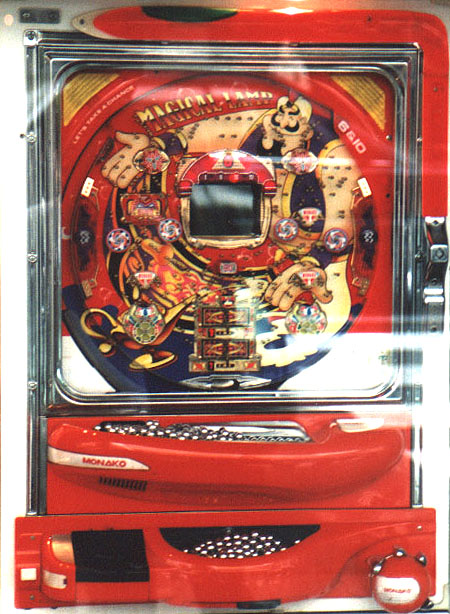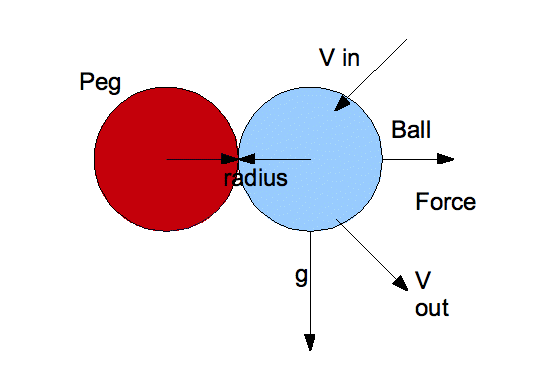Simulated Pachinko
Machine
By Dustin Rhodes
email:
dcrhodes@ucsc.edu
class: cmps161 Winter
2010
 For
my final project I simulated a Pachinko Machine. Balls are dropped
from the top and trickle down bouncing off of various pins and
bumpers until they land somewhere along the bottom.
For
my final project I simulated a Pachinko Machine. Balls are dropped
from the top and trickle down bouncing off of various pins and
bumpers until they land somewhere along the bottom.
Executable: Download
Source:
Download
Controls:
a = add new ball
+/- = increase/decrease gravity
space = pause simulation and set v=0
click and drag to move any pegs,balls, or polygon points
reopen for a new layout of pegs
Necessary Tasks
(completed)
Collision between balls
and each other and balls and other aspects of the machine
Launching of the metal
balls into the play area (balls fall in from top of screen)
Correct physical
responses to collision with balls and pegs
Correctly implement
“walls” or flat non peg areas where the balls can slide along or
bounce off of
Optional Tasks
Reading
in the layout from a file (layout is randomly generated)
Other
interactive machine components such as
Plan for Execution
To
implement collision between balls and the various parts of the
playing field I used the equation of a circle because the spheres and
pegs are both circular on the 2D field of the playing area. Once a
collision is detected a force is calculated based on the collision
direction and that force is applied to either just the ball in case
of a ball on peg collision or both balls in case of a ball on ball
collision. All collisions are mostly elastic but do contain some
inelasticity and momentum is conserved. A small amount of friction
was added. To add friction we apply a small force in the opposite
direction of ball movement.

Timeline
Week 1:
Complete program 3 in an easily extensible way. IE. Walls can be
drawn anywhere and it is easy to add a peg element.
Week 2:
Transform program 3 into a ball falling through many many pegs with
walls at the bottom and sides.
Week 3:
Add friction if necessary. Fix any imperfections with collisions
between balls and pegs or balls and each other. Start working on
different elements.
Week 4:
Work on adding extras and adding extras that make the program look
nice.
Physics
Ball vs. Ball
A
collision between two balls occurs when the distance between their
centers is less then their combined radii. After a collision is
detected the new velocities of the two balls must be calculated. To
calculate this the collision is broken up into two 1 dimensional
collisions one of which is parallel to the radii and the other is
perpendicular. In other words for any two dimensional collision we
can rotate our access so that it can be viewed as a one dimensional
collision. Once we have the 1 dimensional equation we must solve for
the new velocities using conservation of momentum and conservation of
energy...
m1*v1+m2*v2
(before)=m1*v1+m2*v2(after)
1/2m1*v1^2+1/2m2*v2^2
(before) = 1/2m1*v1^2+1/2m2*v2^2 (after)
for my
program I set m=1 for each circle. This simplifies the equation
into...
v1+v2
(before) = v1+v2 (after)
v1^2+v2^2
(before) = v1^2+v2^2 (after)
We know
v1 and v2 before so we can plug these in and solve for the two
unknowns v1 and v2 after. This will give us the new velocities
parallel to the collision and the ones perpendicular to the collision
remain unchanged.
Ball vs. Peg
To
detect a collision between a ball and a peg is the same as between a
ball and a ball. Once a collision is detected we solve the same
equations as before but the peg is given an infinite mass. This
means that the peg will not move no matter how fast the ball is
coming at it.
m1*v1+m2*v2
(before)=m1*v1+m2*v2(after)
1/2m1*v1^2+1/2m2*v2^2
(before) = 1/2m1*v1^2+1/2m2*v2^2 (after)
plugging
in 1 for m1 and infinite for m2 we see that v2 must remain 0
v1+infinite*0
(before) = v1+infinite*v2 (after)
v1 = v1
+infinite*v2
v1/infinite
= v1/infinite + v2
0 = 0
+v2
v2=0
after
solving for v2 we must calculate the new v1
1/2m1*v1^2+1/2m2*v2^2
(before) = 1/2m1*v1^2+1/2m2*v2^2 (after)
v1^2 +
0 (before) = v1^2 + 0 (after)
therefore
we see that the magnitude of v1 remains the same but the velocity is
negated. We now convert back to our original coordinates just like
in the previous case.
Ball vs. Polygon
To
detect a collision between a ball and a polygon we find the closest
point on the lines that make up the polygon. If this point is closer
then the balls radius we have a collision. Again we can assume that
the mass of the polygon is infinite so we find that the new velocity
is negated in the direction of the collision and stays the same
perpendicular to the collision.

 For
my final project I simulated a Pachinko Machine. Balls are dropped
from the top and trickle down bouncing off of various pins and
bumpers until they land somewhere along the bottom.
For
my final project I simulated a Pachinko Machine. Balls are dropped
from the top and trickle down bouncing off of various pins and
bumpers until they land somewhere along the bottom.
